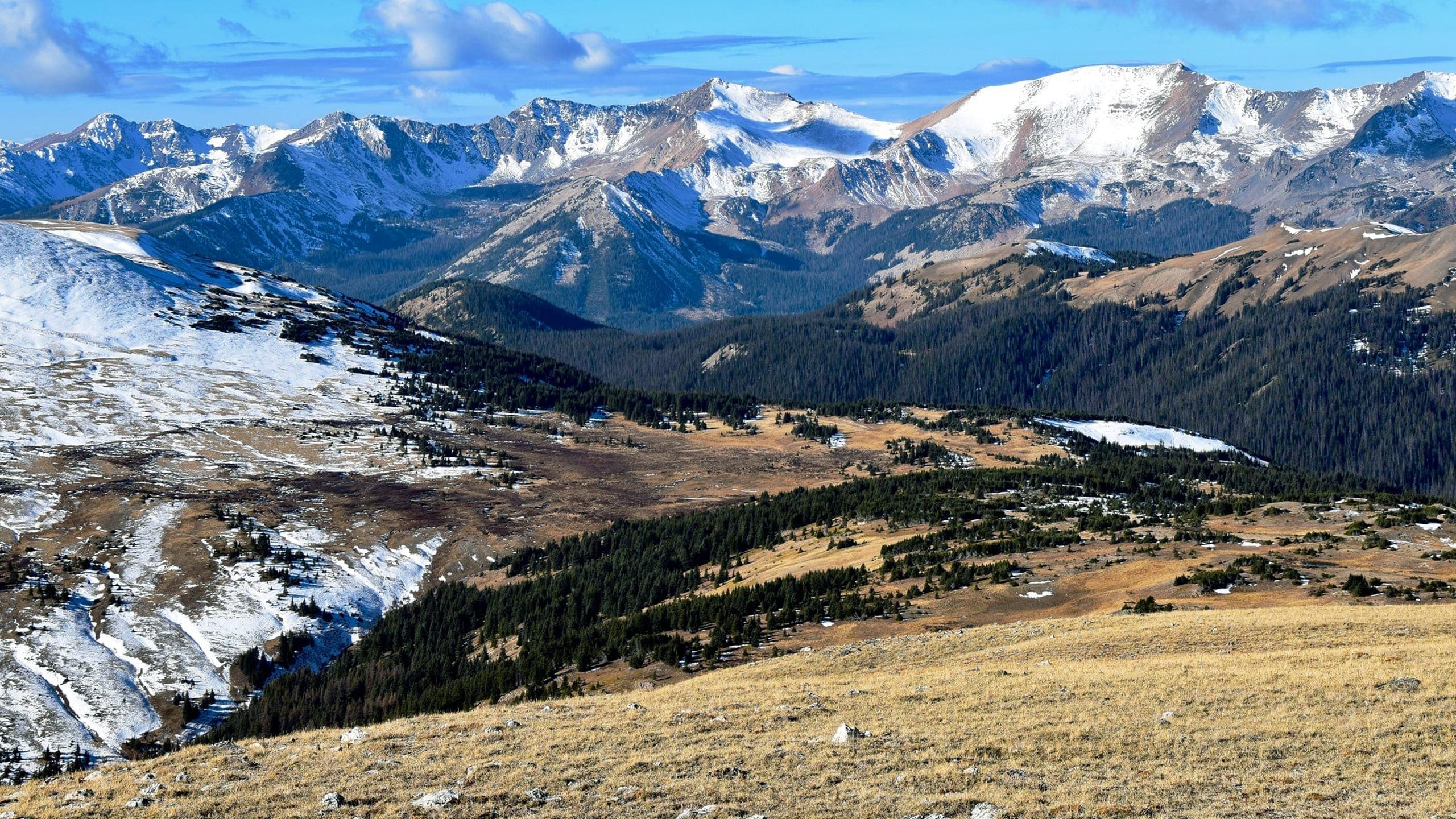About Rocky Mountain National Park
Established by Congress on January 26, 1915, Rocky Mountain National Park encompasses 265,761 acres or 415 square miles of the scenic southern Rocky Mountains. Nearly one-third of the park is above tree line, or higher than 11,400 feet in elevation. Seventy-two named peaks rise above 12,000 feet, with the high point being the expansive summit of Longs Peak at 14,259 feet. The mountains provide Rocky Mountain National Park with its sense of wonder and inspiration. These great peaks contribute mightily to the “wild, fantastic views” that thrilled noted British visitor Isabella Bird more than a century ago.
The park’s mountains support a diversity of ecosystems, including montane, subalpine, and alpine biological communities, ranging in elevation from 7,600 to 14,259 feet. The park also includes lush riparian and aquatic ecosystems based in 147 lakes and 450 miles of streams that speckle and divide the other ecosystems. Stands of ponderosa pine, Douglas-fir, lodgepole pine, aspen, subalpine fir, and Engelmann spruce adorn the mountainsides. The forests are interspersed with mountain meadows.
Rocky Mountain National Park ranks as one of America’s premier wildlife watching destinations, showcasing elk, bighorn sheep, mule deer, moose, black bears, coyotes, cougars, eagles, hawks, ptarmigan, and scores of smaller animals. The park provides refuge for about 60 mammal species and more than 280 recorded bird species, as well as 6 amphibians, 1 reptile, 11 fish, and countless insect species, including a large number of butterflies.
The lands now known as Rocky Mountain National Park have been home to humans for at least 10,000 years. Human evidence surfaces in a wide range of places within the current park boundaries; including the edge of glaciers, across the Continental Divide, and in valleys throughout the park. Aboriginal people, explorers, homesteaders, miners, hunters, and dude ranchers have used the area at one time or another. Archeological sites and both remnants of buildings and structures exist in the park as a record of human activity. (Only about half of the park has been surveyed for archeological sites.) The park’s archeology and historic structures environment illustrates the history of the park from American Indian use, to homesteader ranches, to its growth through the rustic phase that includes work by the Civilian Conservation Corps (CCC), and up to the Mission 66 period when parks were being updated to keep up with the burgeoning tourism industry that arrived after World War II ended. Some of these sites are eligible for the National Register of Historic Places or are already on the national register and are protected in the park.
In 1977, UNESCO included Rocky Mountain National Park in the international system of biosphere reserves, in addition to designating three research natural areas in the park as core areas of the reserve. Biosphere reserves are sites that are recognized for their roles in conserving genetic resources; facilitating long-term research and monitoring; and encouraging education, training, and the demonstration of sustainable resource use.
In 1986, 75 miles of the Cache la Poudre River were designated as part of the National Wild and Scenic Rivers System. The 14 miles of the Poudre within Rocky Mountain National Park are to be protected for their “outstandingly remarkable values,” be preserved in their “free-flowing condition,” and they and their immediate environments are to be protected for the benefit and enjoyment of present and future generations (Wild and Scenic Rivers Act, October 2, 1968).
In 2009, Congress designated the Rocky Mountain National Park Wilderness Area, covering about 252,085 acres, or 95% of the park. Wilderness designation protects the land’s wilderness character, natural, untrammeled, and undeveloped conditions, opportunities for solitude and primitive recreation, and scientific, educational, and historical values.
Rocky Mountain National Park’s wide range of elevations and habitats offer a wide variety of opportunities for visitors. Over 355 miles of trails offer opportunities to hikers and backpackers. Many trails are available to horseback riders, including portions of the Continental Divide National Scenic Trail. Frontcountry and backcountry campers have hundreds of campsites to choose from. Mountain climbers, anglers, bird-watchers, and photographers have many opportunities to pursue their interests in the park. Visitors can also drive Trail Ridge Road, which topping out at 12,183 feet is the highest, continuous, paved road in the United States. Trail Ridge Road is designated as an All American Road by the U.S. Department of Transportation and one of 10 designated American Byways in Colorado. Although most visitors come in the summer, during the winter snowshoers and cross-country skiers can enjoy the tranquility of snow-clad meadows and forests. In 2011, a total of 3,394,326 recreational visits were recorded in the park, making Rocky Mountain National Park the 23rd most visited park unit, and the 5th most visited national park in the national park system.
The gateway communities of Grand Lake, Estes Park, and Allenspark provide visitors with a variety of services to enhance their enjoyment of the area. A majority of the connected lands are managed by the U.S. Forest Service, including the Roosevelt and Arapaho National Forests, and the Rawah, Neota, Comanche Peak, and Indian Peaks Wilderness areas.
Source: Foundation Document – Rocky Mountain National Park
Fast Facts:
| Date the Park was Established: | January 26, 1915 |
| Park Area (as of 2019): | 265,807.25 acres (1,075.7 km2) |
| Recreational Visitors (2018 Total): | 4,590,493 visitors |







